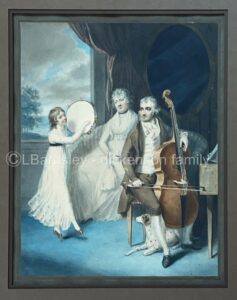The Mary Hamilton Papers team have been grateful to the Anson family for their ongoing support and enthusiasm for the project. In this guest blog post, Hope Anson reflects on her experience of exploring her ancestor's archive, and of following the progress of the project.

The Dickenson Family – Photo by L Barnsley, courtesy of the Anson family
Mary Hamilton and the Unlocking the Mary Hamilton Papers project have been a huge part of my life for the past few years. Not only is Mary my five-times- great-grandmother, but I am also obsessed with studying the past.
I first heard of Mary at my grandparents’ house, where a picture of Mary, her husband John Dickenson and their daughter Louisa (later Louisa Anson) hung in the living room. However, it was only when I heard of this research project that I fell down the rabbit hole and decided I needed to understand who Mary was. This culminated in Mary becoming one of two Hamilton women at the focus of my master’s dissertation. I investigated her friendship with Queen Charlotte of Mecklenburg-Strelitz, George III’s wife, and how their relationship dramatically changed after Mary left her position as sub-governess for the Queen and her husband’s daughters. The Hamilton project and the digital edition the team have created became invaluable to me. I am also grateful for the time they gave me when I needed to discuss Mary’s life and documents.
One source I found fascinating was HAM/2/15, which is a volume which mostly comprises a series of journal-letters that Mary wrote to her then fiancé John Dickenson, covering the period between 27th December 1784 and 22nd May 1785. In it, Mary details how troubled she was by seeing George, Prince of Wales (later George IV), who had been romantically obsessed with her during her tenure at court (1777-82).[1] He came up to her carriage and would not let go of her hand, leaving her unable to remove herself from the uneasy situation. It felt like an 18th-century #MeToo moment. When looking at people from the past I often feel we forget that they were human and, in many ways, just like people today. Sources such as this help us to remember the real emotions people experienced.
My whole family is so grateful to the Mary Hamilton project team for taking the time to research and bring Mary and her vast amounts of diaries and correspondence to light. Thank you, and we are looking forward to the publishing of all the findings.
—
Hope Anson, December 2022
Notes
- On the correspondence between George, Prince of Wales and Mary Hamilton, see Sophie Coulombeau's blog 'This is not a love story: Mary Hamilton and George IV'.
